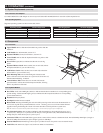
8
5. Installation
5.1 General Safety Instructions
Read all of these instructions. Save them for future reference.•
Follow all warnings and instructions marked on the device.•
Donotplacethedeviceonanyunstablesurface(cart,stand,table,etc.).If•
the device falls, serious damage will result.
Donotusethedevicenearwater.•
Donotplacethedevicenear,orover,radiatorsorheatregisters.•
The device cabinet is provided with slots and openings to allow for •
adequate ventilation. To ensure reliable operation, and to protect against
overheating, these openings must never be blocked or covered.
The device should never be placed on a soft surface (bed, sofa, rug, etc.) as •
this will block its ventilation openings. Likewise, the device should not be
placed in a built in enclosure unless adequate ventilation has been provided.
Never spill liquid of any kind on the device.•
Unplugthedevicefromthewalloutletbeforecleaning.Donotuseliquidor•
aerosol cleaners. Use a damp cloth for cleaning.
The device should be operated from the type of power source indicated on •
the marking label. If you are not sure of the type of power available, consult
your dealer or local power company.
ThisdeviceisdesignedforITpowerdistributionsystemswithupto230V•
phase to phase voltage.
Thedeviceisequippedwitha3-wiregroundingtypeplug.Thisisasafety•
feature. If you are unable to insert the plug into the outlet, contact your
electriciantoreplaceyourobsoleteoutlet.Donotattempttodefeatthe
purposeofthegrounding-typeplug.Alwaysfollowyourlocal/national
wiring codes.
Donotallowanythingtorestonthepowercordorcables.Routethepower•
cord and cables so that they cannot be stepped on or tripped over.
If an extension cord is used with this device make sure that the total of •
the ampere ratings of all products used on this cord does not exceed the
extensioncordampererating.Makesurethatthetotalofallproducts
plugged into the wall outlet does not exceed 15 amperes.
Consideration should be given to the connection of equipment to the •
supply circuit, and what effect overloading the supply circuit might have on
overcurrent protection and supply wiring.
To help protect your system from sudden, transient increases and decreases •
in electrical power, use a Tripp Lite Surge Suppressor, Line Conditioner, or
Uninterruptible Power Supply (UPS).
Positionsystemcablesandpowercablescarefully;besurethatnothing•
rests on any cables.
When connecting or disconnecting power to hot pluggable power supplies, •
observe the following guidelines:
Install the power supply before connecting the power cable to the power •
supply.
Unplug the power cable before removing the power supply.•
If the system has multiple sources of power, disconnect power from the •
system by unplugging all power cables from the power supplies.
Never push objects of any kind into or through cabinet slots. They may •
touch dangerous voltage points or short out parts resulting in a risk of fire or
electrical shock.
Donotattempttoservicethedeviceyourself.Referallservicingto•
qualified service personnel.
If the following conditions occur, unplug the device from the wall outlet and •
bring it to qualified service personnel for repair:
The power cord or plug has become damaged or frayed.•
Liquid has been spilled into the device.•
The device has been exposed to rain or water.•
The device has been dropped, or the cabinet has been damaged.•
The device exhibits a distinct change in performance, indicating a need •
for service.
The device does not operate normally when the operating instructions •
are followed.
Only adjust those controls that are covered in the operating instructions. •
Improper adjustment of other controls may result in damage that will
require extensive work by a qualified technician to repair.
Use of this equipment in life support applications where failure of this •
equipment can reasonably be expected to cause the failure of the life
support equipment or to significantly affect its safety or effectiveness is not
recommended.Donotusethisequipmentinthepresenceofaammable
anesthetic mixture with air, oxygen or nitrous oxide.
Rack Mounting
The ambient operating temperature in the rack may be an issue and is •
dependent upon the rack load and ventilation. When installing in a closed
ormulti-unitrackassembly,makesurethatthetemperaturewillnotexceed
themaximumratedambienttemperature(0°to40°C).
Before working on the rack, make sure that the stabilizers are secured to the •
rack,extendedtotheoor,andthatthefullweightoftherackrestsonthe
oor.Installfrontandsidestabilizersonasinglerackorfrontstabilizersfor
joined multiple racks before working on the rack.
Always load the rack from the bottom up, and load the heaviest item in the •
rack first.
Always load the rack so that a hazardous condition is not created due to •
uneven loading.
Makesurethattherackislevelandstablebeforeextendingadevicefrom•
the rack.
Use caution when pressing the device rail release latches and sliding a •
deviceintooroutofarack;thesliderailscanpinchyourngers.
After a device is inserted into the rack, carefully extend the rail into a •
locking position, and then slide the device into the rack.
DonotoverloadtheACsupplybranchcircuitthatprovidespowertothe•
rack.Thetotalrackloadshouldnotexceed80percentofthebranchcircuit
rating.
Ensurethatproperairowisprovidedtodevicesintherack.•
Donotsteponorstandonanydevicewhenservicingotherdevicesina•
rack.


















